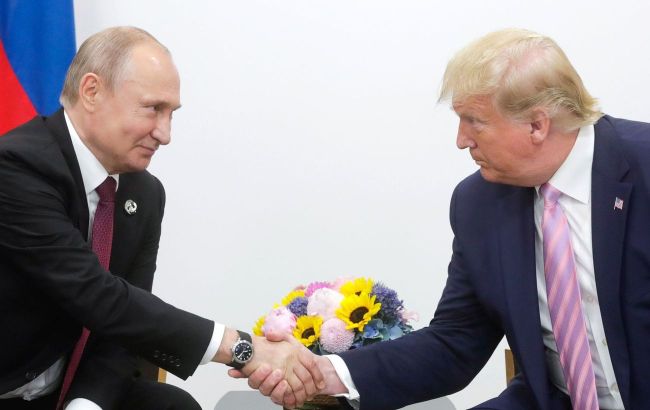Ahead of Alaska meeting: Three scenarios for Ukraine after Trump-Putin talks
 Vladimir Putin and Donald Trump (photo: Getty Images)
Vladimir Putin and Donald Trump (photo: Getty Images)
To know about the positive, neutral, and disastrous-for-Ukraine scenarios after the meeting between Donald Trump and Vladimir Putin in Alaska - read RBC-Ukraine's column on the topic.
With Donald Trump you never know - that’s one of the most popular phrases in any forecasts involving the US President. It concerns any area: from personnel decisions to trade tariffs.
Ahead of the meeting in Alaska, it is used especially often – by both Western media and experts, as well as RBC-Ukraine’s sources in the Ukrainian government and among Western diplomats.
Despite the fact that in the past few days, Ukrainian authorities and European allies have made every effort to explain to Trump all possible principles, pitfalls, and red lines for the talks, no one knows what will come out of it by Saturday morning Kyiv time.
But based on public statements by Trump, Zelenskyy, and European leaders, reports in Western media, and behind-the-scenes information, it is possible to at least outline the general scenarios.
Trump pushes for ceasefire
From Trump’s numerous comments before the summit, it is quite difficult to put together a complete picture of exactly what he plans to do in Alaska and with whom he plans, or does not plan, to make his deals.
However, one recurring idea is noticeable – Trump seems determined to seek a complete ceasefire. At least, that is what he promised Europeans this week.
An unconditional, comprehensive ceasefire is exactly what Ukraine and its European allies have been constantly talking about for the past few months. And it’s exactly what Putin has been avoiding under various pretexts: either unilaterally declaring a ceasefire for a couple of days, or demanding to discuss some “modalities” first.
As RBC-Ukraine has previously reported, a ceasefire is one of Putin’s main bargaining chips, which he can use only once, so he certainly won’t want to give it away cheaply.
While speaking to journalists this week, Zelenskyy repeatedly emphasized that the American President actually has all the levers to force Putin to make concessions, even against his will. For example, by threatening the harshest sanctions that were planned to be imposed last week. Or even the “nuclear option” - actually imposing these sanctions, with the promise to lift them immediately if Russia stops shooting.
That way, it would finally be possible to destroy Putin’s simple but effective scheme – refusing a ceasefire under any pretext while continuing the offensive in eastern Ukraine and strikes on rear targets.
Of course, even under this most favorable-for-Ukraine scenario, the Alaska summit will only be the beginning of a long process.
First of all, no ceasefire agreement will work without effective monitoring mechanisms. Considering the length of the front line, this will require significant human and technical resources, and it will hardly be possible to do without active American participation as de facto watchdogs.
In addition, as Ukrainian authorities have repeatedly stated, in the event of a stable ceasefire, the sides will be ready to discuss any issues related to a peaceful settlement. Including, obviously, painful compromises.
Still, if Trump actually brings back from Alaska not only a ceasefire but also a more or less firm agreement from Putin to meet with Zelenskyy (which so far seems completely unrealistic, even in a Trump-Zelenskyy-Putin format), then it will finally be possible to say that the peace process has moved off dead center. Essentially, for the first time in more than three years.
Putin outplays Trump
It is noteworthy that all participants on the Ukrainian side - the US, EU + UK, and Ukraine itself - are urging people not to set expectations too high ahead of the meeting. In Europe, many believe that the summit may, in fact, end with nothing, and there are many ways for it to reach such an outcome.
For example, Putin may present to Trump as progress some kind of air ceasefire, especially since such ideas were already floated in Western media before Steve Witkoff’s visit to Moscow. Or convince Trump that progress is impossible without setting up a dozen working groups in some neutral place like Istanbul - a signature method of aggressors dating back to the war in Donbas. Especially since it has already worked once with Trump – when in May, in response to demands from Kyiv and other European capitals, the Kremlin proposed delegation talks in Istanbul - and Trump eagerly accepted the idea.
Or Putin might persuade Trump that Ukraine is supposedly losing the war anyway, handing him fresh printouts from the Western press with very dramatic headlines describing the situation near Dobropillia in the Donetsk region.
RBC-Ukraine previously heard that at one time, Americans were very surprised that Ukraine did not agree to yet another set of terms put forward by the aggressors, reportedly telling them that they were losing the war, that this was their last chance, and that later it would be too late, so they should agree. It took Ukrainian negotiators considerable effort to explain the real situation to their interlocutors.
 Online meeting of the Coalition of the Willing on August 13 (photo: president.gov.ua)
Online meeting of the Coalition of the Willing on August 13 (photo: president.gov.ua)
Finally, Ukraine will not be the only topic on the summit’s agenda. Moscow especially likes to emphasize this: that war is, of course, important, but the leaders will also have plenty of other issues to discuss - the Arctic, cooperation in space, and so on. Accordingly, Putin may well divert Trump’s attention away from his key task.
Probably only temporarily, if Trump sees that there is no progress at all on the main issue, Russia’s aggression against Ukraine, one can expect a new wave of activity from him. But Putin will, in any case, win himself some time.
Ukraine gets blamed again
There is no doubt that, unlike Trump, who will rely on his feel for the interlocutor and his deal-making skills (known mostly from his own words), the Kremlin leader will arrive at the meeting with a pile of pre-prepared talking points. Ranging from stories about the Russian Arctic to pseudo-historical tales about the non-existent Ukraine.
Once he “softens” his interlocutor, Putin can move on to the main task: convincing Trump that what separates him from the Nobel Peace Prize is not Putin himself - but Zelenskyy, who ”wants to keep fighting.” Here again, headlines about “massive Russian breakthroughs” in recent days will come in handy. The argument will be that Putin has long been ready for the peace Trump desires, but Zelenskyy refuses to give up, say, some part of Donbas, which he will inevitably lose soon anyway.
Of course, all the diplomatic work of the past few days has also been aimed at avoiding such a worst-case scenario. At the very least, Trump has repeated several times that he will not decide territorial issues for Ukraine that should be done by Zelenskyy and Putin.
But given the experience of the past six months, it still cannot be ruled out that Putin will once again successfully sell Trump some symbolic concessions, while real concessions will be demanded from Ukraine. Then Ukraine will, in essence, return to where it was in March of this year - with the difference that such a turn of events will no longer be a surprise, but an entirely expected possibility.
As will be any other possibilities. Including the scenario in which Trump gives Putin an “Oval Office #2” and the summit ends very quickly if the American president, contrary to expectations, immediately realizes that Putin is trying to play him. After all, with Trump, you never know.

